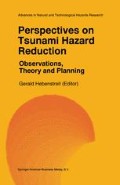Abstract
Data of the Meijii and Showa Great Sanriku tsunamis are analyzed. When a tsunami higher than 5 m hit coastal cliffs, a “thunder-like” sound is generated and heard at distant places: The plunging breaker of a tsunami higher than 4 m generates a sudden “thunderbolt-like” sound which is heard only at the beach of the plunging. When a tsunami higher than 2.5 m with a front in the form of a spilling breaker proceeds in the shallow water, a continuous sound like a locomotive can be heard in the area. Some of these sounds may be used as a precursor of tsunami. An example of the blank spot in the area where sounds were heard is shown.
Access this chapter
Tax calculation will be finalised at checkout
Purchases are for personal use only
Preview
Unable to display preview. Download preview PDF.
References
Ambraseys, N. N., 1962. Data for the investigation of the seismic sea-waves in the Eastern Mediterranean, Bull. Seism. Soc. America, 52, pp. 895–913.
Council for Earthquake Disaster Prevention, 1933. Notes on the tsunami disaster prevention, for example, in Showa Earthquake and Tsunami in Miyagi Prefecture, published by the Miyagi Prefecture, pp.451–460 (in Japanese).
Hei District, Iwate Prefecture, 1897. Report on the tsunami in the South Hei District, Rikuchu, Iwate Prefecture,p.132, pp.186–187 (in Japanese).
Honda, K. and M. Takehana, 1933. Measured data of the strong earthquake off Sanriku, Kenshin Jiho, 17, No. 2, pp. 87–103 (in Japanese).
Kajiura, K. and N. Shuto, 1990. Tsunamis, The Sea edited by LeMehaute and Hanes, Wiley Interscience, 9 Part A, pp.395–420.
Mori, K., 1933. Tsunami history of Iwate Prefecture, Research of the Economy in Nanbu-ha, Series 4, reprinted from Iwate Education, Vol.11, Nos.6, 7 and 9, pp. 31–32 (in Japanese).
Shuto, N., 1993. Tsunami intensity and disasters, Tsunamis In The World, edited by S. Tinti, Kluwer Academic Publishers, pp. 197–216.
Author information
Authors and Affiliations
Editor information
Editors and Affiliations
Rights and permissions
Copyright information
© 1997 Springer Science+Business Media Dordrecht
About this chapter
Cite this chapter
Shuto, N. (1997). A Natural Warning of Tsunami Arrival. In: Hebenstreit, G. (eds) Perspectives on Tsunami Hazard Reduction. Advances in Natural and Technological Hazards Research, vol 9. Springer, Dordrecht. https://doi.org/10.1007/978-94-015-8859-1_11
Download citation
DOI: https://doi.org/10.1007/978-94-015-8859-1_11
Publisher Name: Springer, Dordrecht
Print ISBN: 978-90-481-4938-4
Online ISBN: 978-94-015-8859-1
eBook Packages: Springer Book Archive

